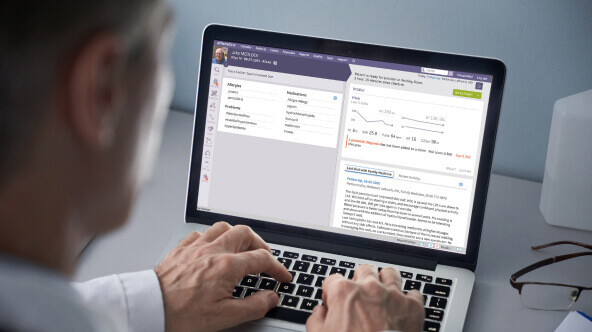
Healthcare technology can empower the patient experience of tomorrow

How many times do we re-enter the same information for a specialist check-in that we just gave to our primary care physician – forgetting half of what we entered just a week prior? How many of us have gone to the doctor for our annual physical, only to never walk down the hall and complete the physician’s suggested bloodwork?
Those of us who work in healthcare are just as guilty of getting caught up in the swirl of life as the average patient – if there is such a thing. But the patient experience of tomorrow, no matter what our profile, is getting here faster than we all might expect. The adoption of new capabilities that connect network providers means patients won’t have to fill out duplicative forms. Pre-encounter chart preparation, like that adopted by Summit Health, means healthcare organizations can adopt proactive versus reactive models, surfacing care gaps and suggesting evaluations such as glucose or cholesterol tests ahead of time to discuss results face to face.
These innovations don’t only enable a world in which healthcare meets the increasing digital literacy of its patient population. Such improvements also support a healthier ecosystem in which providers are more satisfied because they’re delivering care more efficiently, and payers can focus on controlling their costs and those of their members.
Doing a 180 towards 360
The past three years have shown us that care can be received and delivered from almost anywhere. But that’s not only about whether the appointment itself is virtual or not. Empowering the patient experience of today, tomorrow – and five years from now – will always be about convenience, access, and consistency, no matter what stage of the journey.
Upgrading patient self-check-in capabilities is essentially the equivalent of transitioning from a Phillips head screwdriver to an electric drill.
-Curtis Sherbo
The cure for what ails healthcare may just be giving patients the right tools to engage in their own care and ensuring those tools are easy to use. Upgrading patient self-check-in capabilities is essentially the equivalent of transitioning from a Phillips head screwdriver to an electric drill. Now, rather than awkwardly balancing a clipboard on our laps, we have the capacity to check in online with just two thumbs from the comfort of our couch. There’s no more rush to complete four sheets of Xeroxed paper with five minutes until your scheduled appointment time; if you’re anything like me, those situations are more about trying to fly through while making my handwriting legible. I’m more likely to fill out more accurate and complete information while not under the (speed) gun.
The impact ripples across the rest of the continuum, too. If I’m a provider, I now have the ability to review patient information in advance. Neither my staff, nor myself, has to input anything manually that’s already been put into another system across town by another doctor’s staff. Having a more complete, sharable health history that cuts down on redundant work is only a prognosis for progress.
Taking it a step further
Now what if I didn’t have to fill out any paperwork at all, and let my watch fill in the blanks? For those of us who grew up watching Inspector Gadget, being able to make a phone call from my wrist seemed like the ultimate fantasy – never mind having that same device track my steps or heart rate. But what if we were able to ensure that the same data is just as accessible to our providers without lifting a finger (or, five)? What if we enable such trackers to use AI to note abnormalities in our blood pressure and notify us or our doctors? Making sure such information gets shared with athenahealth’s mobile application from multiple health, diet, and exercise applications ultimately enables patients to be more proactive and engaged in longitudinal progress.
The benefits of telehealth apps are wonderful, but most of us only need them two to three times a year. Technology that aggregates data and makes it easily accessible via user-friendly tools puts more of a focus on longitudinal wellbeing versus specific episodes. The onus there shouldn’t only be on the patient; providers and their solution partners need to motivate patients to make behavioral changes. Technology integration isn’t about only offering up tools, but influencing human conduct, too.
Making the best use of time, energy
Telehealth is just one modality that’s opened everyone’s eyes to the possibilities associated with enabling access and care continuation. One of the other such tools may not be so much about what happens in the visit itself, but rather getting that encounter scheduled in the first place.
For those of us who’ve sat on the phone for a half-hour on a Monday morning or during lunch trying to get an appointment – and for those tasked with answering those calls – patient self-scheduling may ultimately be one of the easiest ways to enable access and provide a better experience in a world in which healthcare revolves around increasingly consumerist principles.
When we can reduce phone calls and allow patients to schedule appointments at any time day or night, patients really love that.
-Lynn Joffe, M.D.
“When we can reduce phone calls and allow patients to schedule appointments at any time day or night, patients really love that,” said Dr. Lynn Joffe of Colorado-based DTC Family Health, a beta customer for athenahealth’s Consumer Scheduling solution. “Scheduling issues are just not as burdensome as they were.”
Surely, that’s both on the clinicians’ side and that of the patients’. While altering a matrix of appointment types, clinician availability, and the types of technology or exam rooms required is certainly more complex than most outside of a clinical setting realize, the ability to simply flip a switch to enable – or disable – Patient Self Scheduling is a decision worth weighing. Especially when financial viability increasingly depends on patients’ perceptions of their care and not necessarily the care itself.
Another way to enhance access that makes for a better experience, no matter what side of the exam room table you’re on, is the evolution of referral technology. No longer do providers or their staffs have to hand over photocopies of lists of specialists for their patients to call after initial consults; dropdown menus can help determine who’s most convenient geographically and in-network, making the process more efficient clinically and financially.
A more transparent vision of the future
We live in a day and age when you know how much a pizza delivery will cost and how long it will take to arrive via apps that interact with dozens of other platforms in mere seconds. But when it comes to healthcare – which can cost hundreds, if not thousands of dollars more — we are often left to wonder. In many cases, this means additional worry, stress, and putting off care that can exacerbate conditions.
It doesn’t have to be that way. And there’s not always a clear definition of whether the patient experience is clinical, financial, emotional, or all of the above.
“Simple” solutions like image capture for insurance cards help us get accurate plan information sooner to assist practices in running more comprehensive eligibility checks. Thanks to ongoing data exchange partnerships with payers, there are more opportunities to surface good faith estimates at the point of care to determine treatment, or alternate forms of care. Having more information about the cost of treatment when it comes to prescriptions has been already proven to enhance medication adherence. There’s no reason to believe that there won’t be a correlated impact for a patient who’s more informed about the cost of their care, or at least experience less stress when it comes to the unknown.
Ongoing regulatory measures intend to do the same. As of January 2023, the Transparency in Coverage Act requires payers to make available pricing information for a list of 500 specific items and services. By January 1, 2024, plans and issuers must make price comparison information available with respect to all covered items and services. While typically this data isn’t exactly in the most user-friendly file formats (usually CCDA printouts of internet tools), it’s light years’ worth of cultural transformation when considering that as few as five years ago, we’d just get surprise bills via snail mail.
Other measures like the Information Blocking Rule put more power in the hands of the patient. Providers are now mandated to give patients access to all the health information in their own electronic medical records. Formerly, patient data was under the purview of the provider organization where the patient received care. Like pricing information, this clinical data today isn’t easy to read. But it is available. In a world where knowledge is power, and patients are increasingly becoming their own advocates, it’s a huge step forward in the patient journey.
Curtis Sherbo is athenahealth's vice president of product management for patient engagement.











